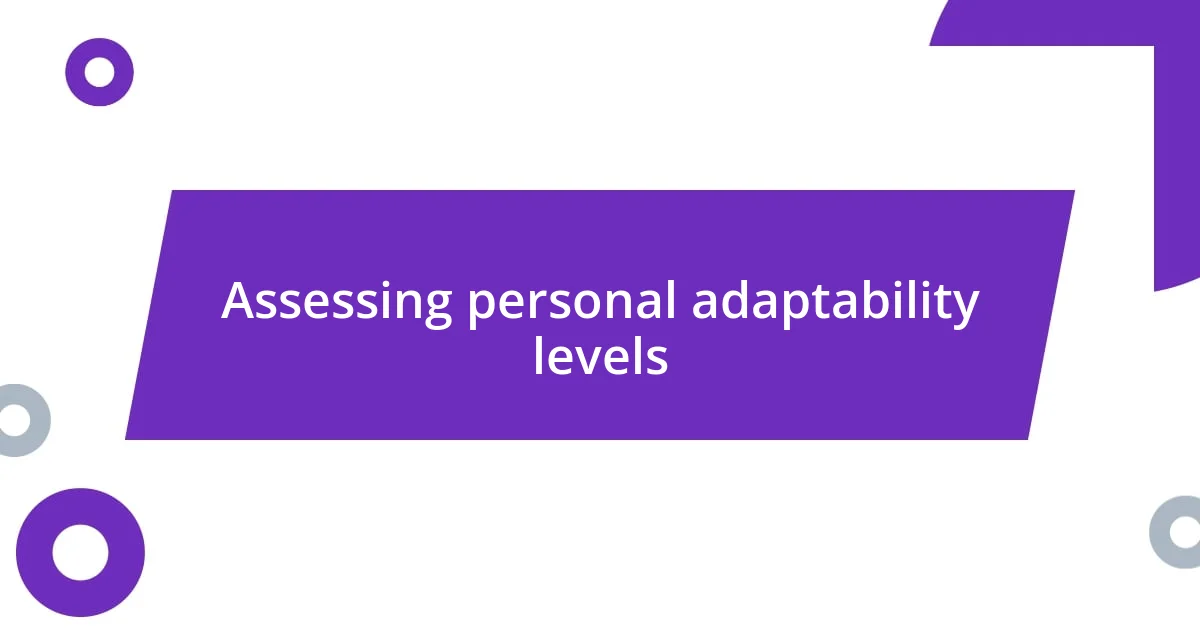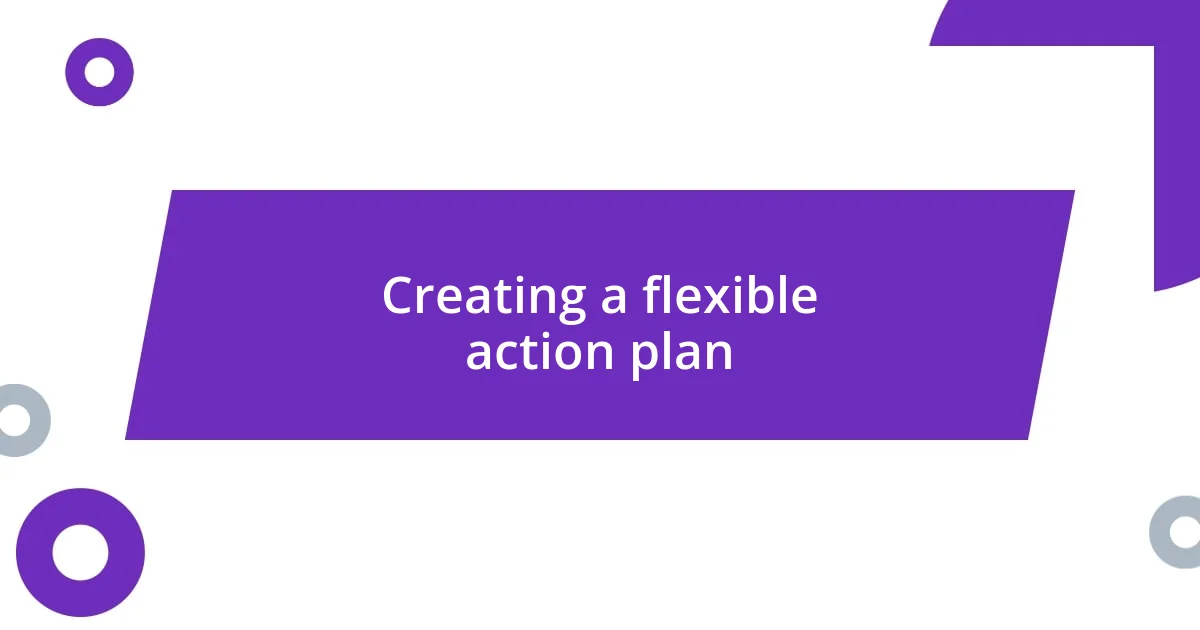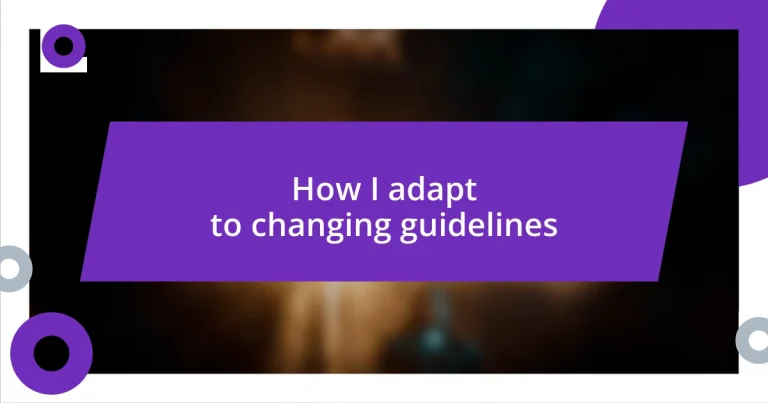Key takeaways:
- Embracing flexibility when adapting to changing guidelines can turn challenges into learning opportunities and foster innovation in one’s career.
- Identifying reliable sources of information is crucial; one should verify author expertise, publication date, citations, source reputation, and whether the material is peer-reviewed.
- Monitoring progress through feedback loops and reflective practices enhances team adaptation and fosters a culture of continuous improvement and collaboration.

Understanding changing guidelines impact
Understanding how changing guidelines impact my work has been both challenging and enlightening. For instance, I remember when a significant guideline shift occurred in my field, and it felt like the ground was shifting beneath me. How does one adjust to such sudden changes? I found that embracing flexibility was key, and it led me to new methods and practices I’d never explored before.
The emotional weight of adapting can be genuinely overwhelming. I’ve experienced moments of frustration, where I questioned my expertise and the validity of my previous work. Yet, these feelings pushed me to dig deeper into understanding the rationale behind the guidelines. It turned into a journey of growth, where every change became a learning opportunity rather than a setback.
In reflecting on these guidelines, I often ask myself: what if I hadn’t adapted? Without flexibility, I realize I would have missed out on valuable experiences. I think it’s vital to remember that change is often a catalyst for innovation in our careers, encouraging us to reevaluate our practices and improve continuously.

Identifying reliable sources of information
Identifying reliable sources of information can feel like searching for a needle in a haystack, especially when guidelines constantly evolve. I remember a time when I was knee-deep in research and stumbled upon a site that looked legitimate, but the information turned out to be outdated. It was a frustrating moment that taught me to scrutinize my sources more closely. I always check the author’s credentials and the date of publication to ensure I’m relying on trusted information.
To help you navigate the web of information, here are some quick tips on identifying reliable sources:
- Author Expertise: Look for authors who are recognized in the field and have relevant qualifications.
- Publication Date: Ensure that the information is current and applicable to the latest guidelines.
- Citations and References: Reliable sources often cite other trusted materials or include references.
- Reputation of Source: Research the credibility of the website or publication where the information is presented.
- Peer Review: Seek out articles or studies that have been peer-reviewed, as this typically adds a layer of credibility.

Assessing personal adaptability levels
Assessing my personal adaptability levels is crucial in today’s fast-paced environment. I recall a project where deadlines shifted unexpectedly, and I had to pivot on a dime. I felt a rush of anxiety at first, but that was quickly replaced by a surge of determination. I learned that my resilience played a significant role in how smoothly I could handle shifting expectations.
One approach I find helpful is to regularly evaluate my comfort with change. For instance, I keep a journal to note my feelings and reactions when new guidelines emerge. Reflecting on these moments reveals patterns in my adaptability, helping me identify areas for growth. Have you ever taken stock of how you respond to change? By tracking those emotions, I can discern whether I’m stagnating or evolving—a realization that often sparks motivation to embrace new challenges.
In my experience, adaptability can also be measured against specific criteria. By comparing factors like emotional response, readiness to learn, and openness to new practices, I can gauge where I stand. It’s an insightful exercise that transforms the abstract notion of adaptability into something tangible and actionable.
| Criteria | Assessment |
|---|---|
| Emotional Response | Calm and focused during changes |
| Readiness to Learn | Willingness to explore new methods |
| Openness to Practices | Seeking out diverse perspectives |

Creating a flexible action plan
Creating a flexible action plan involves embracing the unpredictability of changing guidelines while still being proactive. I’ve found that my most effective plans begin with a broad framework that I can easily adjust. For example, when new regulations were announced mid-project, I quickly drafted a list of potential changes and categorized them based on their immediate impact and urgency. This not only kept my project on track but also allowed me to pivot without losing momentum.
Another essential aspect of my action plan is open communication with my team. In one instance, preparing for a major presentation, I opened the floor for feedback and ideas as soon as the updated guidelines were released. This collaborative approach not only fostered a sense of shared ownership but also led to creative solutions that I wouldn’t have considered alone. Isn’t it interesting how pooling insights can illuminate blind spots we never knew we had?
Moreover, I like to incorporate regular check-ins to assess how the plan is holding up. After implementing changes in response to new guidelines, I set aside time each week to review progress and adjust as necessary. This iterative process has proven invaluable; it allows me to stay aligned with objectives while remaining responsive to the changing landscape. How often do you re-evaluate your strategies? I find that by staying engaged with the process, I cultivate agility that transforms challenges into opportunities for growth.

Developing effective communication strategies
Developing effective communication strategies is essential in navigating change. I remember a time when a sudden shift in project guidelines left me feeling lost. Instead of diving into panic, I chose to call a quick team meeting. We openly discussed our concerns and brainstormed ideas, turning initial confusion into clarity and collaboration. Reflecting on this experience, I realized that prioritizing honest dialogue not only eased anxiety but also strengthened our collective commitment to adapting.
One strategy I find invaluable is to create a communication hierarchy. This means defining who needs to know what and when—think of it as establishing a roadmap for information flow. In practical terms, I often utilize group chats and regular updates to keep everyone in the loop. When unexpected changes arose during a client project, this structure ensured that each team member had instant access to the latest details, preventing misunderstandings that could stall progress. Have you established a similar system? I can’t stress enough how much smoother things go when everyone is aligned.
Lastly, fostering an environment where questions are welcomed is vital. In my experience, people are more willing to adapt when they feel heard. I once had a team member who was hesitant about a new protocol. By encouraging her to express her concerns, we were able to address them collectively. In the end, she became one of the most enthusiastic supporters of that shift. How do you create a safe space for dialogue? Understanding that communication is a two-way street has transformed not only how I engage with others but also how effectively we adapt to the ebb and flow of guidelines.

Monitoring and evaluating your progress
Monitoring your progress is crucial when adapting to changing guidelines. I’ve experienced firsthand the impact of tracking my progress through metrics and milestones. For instance, during a recent project adjustment, I implemented a simple tracking spreadsheet that allowed me to visualize our team’s progress against the new deadlines. Seeing our daily accomplishments laid out made it easier to stay motivated, even on tough days. Have you ever felt disheartened when changes come? I know I have, but those visual cues helped lift my spirits and maintain focus.
As I progressed, I learned the importance of feedback loops, both for myself and my team. After we implemented new strategies, I held informal sessions where everyone could share their experiences. One of my teammates mentioned a struggle with a specific change, and that feedback prompted an immediate adjustment from me. Listening to my team’s points reinforced my belief that we all grow when we share our journeys openly. How have you integrated feedback into your progress checks?
Ultimately, I’ve found that regularly reflecting on both successes and challenges creates a deeper understanding of my progress. I now set aside moments at the week’s end to consider what worked and what needs improvement. It was enlightening to recognize that some changes didn’t yield the expected results, but that’s part of the learning process, right? Embracing this reflective practice has made my approach to adapting not just productive, but genuinely fulfilling. What does your reflection process look like?

Implementing feedback for continuous improvement
Implementing feedback is a cornerstone of continuous improvement, and I’ve seen its transformative power in action. A while back, after launching a new initiative, I asked for direct feedback from my team. It was a bit intimidating to open myself up to criticism, but one colleague brought up a concern that completely reshaped how we approached our tasks. That single piece of feedback was not just a suggestion; it was a gateway to enhance our overall productivity. Have you experienced a moment where feedback shifted your entire perspective?
I always encourage a culture of constructive feedback by leading by example. During project check-ins, I actively ask for thoughts on what’s working and what’s not. One time, a junior member voiced an idea that I hadn’t considered. By implementing that concept, we streamlined our process significantly. The pride I felt when her suggestion led to great results was unmatched, reinforcing how vital every voice is in a team. Do you think you’re fully tapping into your team’s potential?
Furthermore, I’ve learned that acting on feedback creates momentum. After receiving insights, I make it a point to update the team on how we’re adjusting our practices. This not only shows that their input matters, but it also cultivates an environment where continuous improvement feels collaborative. I remember a time when we collectively tackled an issue; the enthusiasm from the team was infectious. It made me realize that as we adapt together, we build a more resilient team dynamic. What has your experience been in fostering such collaboration?














